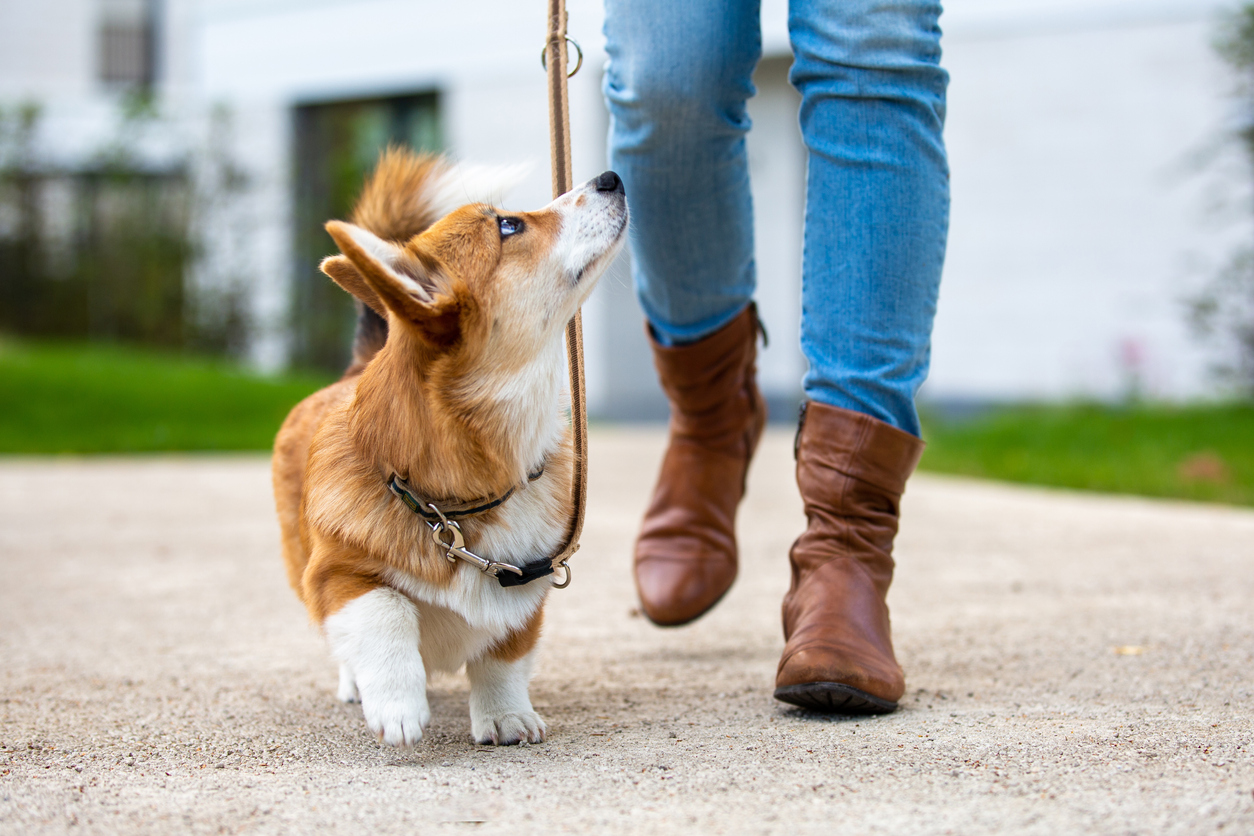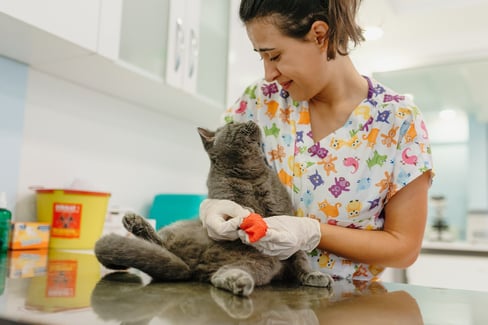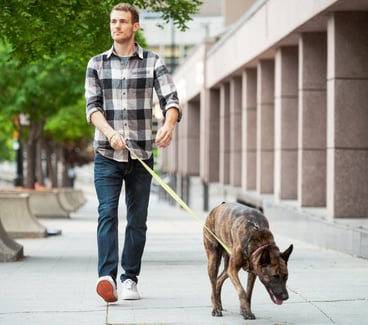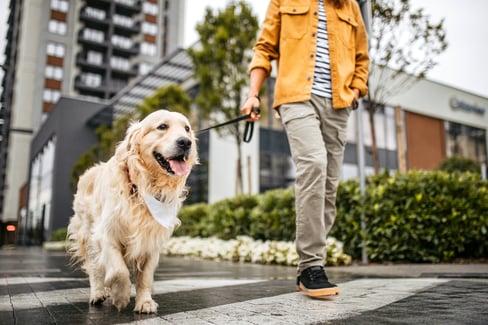Table of Contents
Everything seems normal after a playdate at the park—that is until you notice that your pooch is having some discomfort in its front paw. And, even though it may not seem like a serious injury, as caring owners, we can't help but worry.
If your dog is suddenly limping or his injured paw isn’t getting better, it might warrant a trip to the vet. That’s because these types of injuries can range from mild to pretty serious, and the sooner you get your pup diagnosed, the sooner you can get him back to feeling his best.
This guide details the most common causes and symptoms of a dog holding front paw up and limping, as well as treatment for pups that have been limping for a long time. It’ll also cover how to prevent this from happening in the future!
Why Is My Dog Limping on His Front Paw?
First things first—why is your pup limping anyway?
If you’re dealing with a lame dog, there could be several causes to blame. Some of these dog mobility concerns are fairly mild and can be treated at home with things like R&R and cold compresses. Others, however, are a bit more serious and may call for a visit to the vet.
To figure out which of these you’re dealing with, it pays to know a bit about the symptoms and causes of why you’ve encountered your dog limping on his front paw.
Symptoms of Dog Front Paw Limping
To give you an idea of common symptoms of dog front paw limping, we’ve put together the below table to walk you through common symptoms and what they mean. That way, you’ll know what to be on the lookout for.
| Symptoms |
Description |
| Changes in support points |
Your dog may have difficulty putting weight on or walking with the affected paw. |
| Changes in position |
Your dog may shift their position often to help relieve pressure on the affected paw. They may even lean more on the non-affected side when walking. |
| Inflammation and redness of the area |
This is a common symptom when wounds, scrapes, or scratches cause lameness. The paw may feel warm to the touch, be painful to the touch, and show signs of swelling and redness. |
| General discomfort and mood swings |
Most of the time, you can tell something is wrong because your normally happy pup stops wagging its tail. Your dog may also be irritable or otherwise uncharacteristically aggressive. |
| Dietary changes |
This is one of the most important symptoms, as a suffering puppy may change its eating habits and decrease its appetite. Usually, it does this because they don’t feel well and are too busy worrying about the pain to want to eat. |
| Decreased activity |
Mobility problems will make your dog feel sleepy and choose to spend more time in bed. |
The variety and intensity of lameness can vary, so it has been classified into five clinical degrees for consistency. The highest degree, degree five, is the most extreme and is what requires some serious veterinary attention.
To make it easier to understand, here are the different degrees of lameness:
- Degree 1: The lameness is almost imperceptible and only manifests itself when the dog is about to perform a demanding activity, such as going up or down stairs, jumping, etc.
- Degree 2: Refers to an intermittent and noticeable lameness that manifests after demanding activities such as exercise. The dog will try to change its support points, allowing the owner to realize the problem almost immediately.
- Degree 3: The lameness is continuous or moderate after exercise or sudden movements. The dog may present episodes of lameness that are relieved for some time, but it doesn’t take long for the pain to return.
- Degree 4: The limping is continuous, and there is no support on the paw after exercise of any kind. Your dog is feeling a lot of stress and pain.
- Degree 5: No support on the paw in the resting state, before or after exercise, is the maximum state on the pain scale, so the dog cannot use the limb at all. This is usually due to fissures, fractures, and trauma.
The degree of lameness is also often classified according to its onset, something the veterinarian will probably want to know before treating the lameness.
There are two major types of lameness:
- Acute lameness: appears suddenly in the limb with no previous history, so it’s usually caused by external injuries such as trauma and localized inflammation.
- Chronic lameness: takes weeks or even months to develop and may be continuous or intermittent, which can cause significant psychological damage to the dog.
Remember, your vet will be able to figure out which kind of lameness you’re dealing with and how to respond accordingly. That’s why it’s always best to have a chat with the vet before taking any action so that you can respond appropriately.
Causes of Dog Limping on Front Leg
Now that you know what symptoms you’ve got to be aware of, it’s time to get down to the bottom of your dog’s pain. After all, with the symptoms, you know something’s wrong, but without knowing the cause, you don’t know what’s wrong!
The table below breaks down a couple of the causes for your dog to be hobbling about and lifting his paw up.
| Cause |
Explanations |
| Embedded foreign bodies |
These are foreign objects that have become lodged in the skin, pads, or between the toes of its paw. These foreign bodies can be:
The dog may lick or bite the affected paw in an attempt to relieve the discomfort. |
| Nail overgrowth |
Lack of exercise or neglect of basic care can lead to excessive nail growth, which can injure the paws and cause lameness of varying severity; senior dogs tend to suffer from this condition due to decreased exercise. |
| Trauma |
Paw injuries in dogs are caused by external forces, such as blows, fights, and falls. These traumas can affect the dog's paw's bones, joints, muscles, tendons, ligaments, or skin. A few examples of trauma include:
|
| Joint problems |
These conditions affect the joints, tissues, and related structures, causing stiffness, discomfort, swelling, and pain, usually localized to the hip or knee. However, there are other common joint problems such as:
|
| Tissue infections |
Paw infections, such as cellulitis, osteomyelitis, or pad infections, are also common but dangerous causes of lameness. These infections can be caused by infected wounds, insect bites, or tick-borne diseases and usually affect the connective and nerve tissue in the area. These are very painful and should be treated as soon as possible. |
| Bone diseases |
Bone conditions can cause chronic lameness in pups. A few common bone conditions include:
These are more serious diseases and must be treated with special care. |
| Muscular diseases |
Muscle injuries, strains, tears, or muscle weakness can affect a dog's ability to move properly. These are typically conditions triggered by other factors, such as vitamin loss due to dehydration and/or malnutrition. |
| Systemic diseases |
Of course, other not-so-common health problems can cause lameness as part of their side effects. A few examples are:
|
| Neurological diseases |
Neurological diseases are also a predisposing factor that can affect a dog's motor ability. A few examples of these kinds of diseases include:
|
Common Diagnosis from Dog Limping
Seeing your dog limping is one thing. Knowing how to handle it is another.
The first step in diagnosing your limping dog should be to take your pooch to the vet. Upon arrival at the vet, the first thing that will be done is a physical examination. The doctor will want to rule out injuries caused by external causes, which means stretching your dog’s limb and feeling it to see what might happen.
Once the physical exam is over, your vet will often run blood tests and other, more specialized exams. He or she may also order an X-ray to rule out a fracture or dislocation. Remember, each case is unique, and the veterinarian will use his or her knowledge and experience to determine the underlying cause and provide an appropriate treatment plan.
With all those exams out of the way, it’s time to get a diagnosis in place. The most common diagnosis of a dog holding front paw up and limping is external object trauma. This basically refers to things like excessive exercise, extreme environmental conditions, foreign embedded objects, and other paw pad injuries that are more common than you might think.
Other common causes of dog holding front paw up and limping are:
- Osteoarthritis in aging dogs (over 7 or 8 years)
- Hip dysplasia in genetically predisposed breeds, such as the German shepherd
- Fractures and dislocations, especially in small breeds that have delicate paws or especially energetic dogs
Other, Less Common Diagnosis from Dog Limping
While most cases of your pup limping and not feeling his best can be chalked up to one of the previously mentioned causes, that’s not always the case.
Sometimes, there’s something a bit more obscure going on. Orphan genetic diseases or neoplasms are usually the least frequent diagnoses and require a more specialized clinical and laboratory history to find the basis of the problem.
For example, in the case of neurological disease, the veterinarian should perform a complete neurological examination to assess reflexes, coordination, and nerve function. Additional tests, such as an MRI or cerebrospinal fluid analysis, may also be necessary.
But don’t worry—as we said, these aren’t typical diagnoses when your pup is hobbling around on one foot. Usually, you’re dealing with something simple and straightforward.
Treatment Options for a Dog Lifting Paw and Limping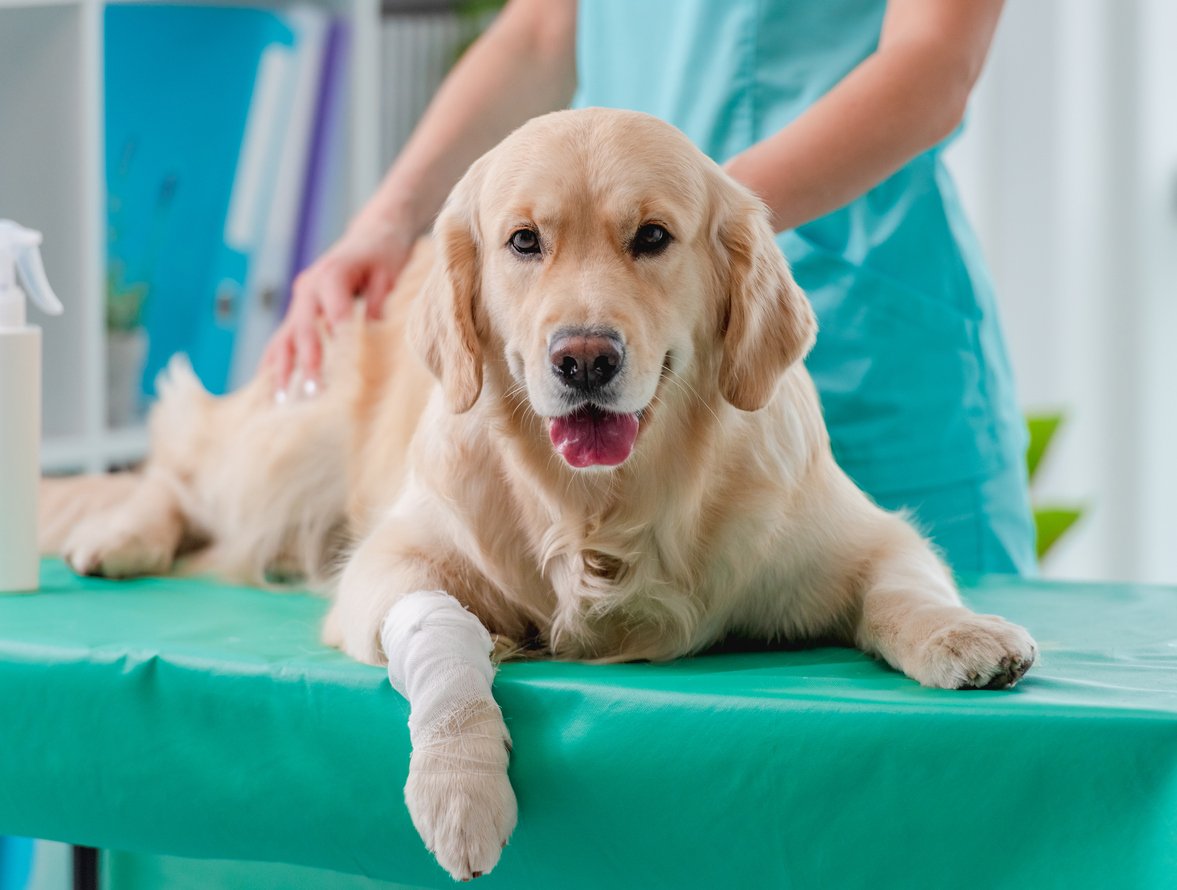
Treatment for a dog holding front paw up and limping will depend on the underlying cause of the lameness. It’s always important to consult a veterinarian for an accurate diagnosis and treatment plan tailored to your pup's special needs.
However, the good news is there are also some simple remedies you can put forth in the event that your dog isn’t feeling so well. A few common home remedies include:
- Rest and relaxation
- Hot or cold compresses
- NSAIDs and pain medication
- Joint supplements
To go into more specifics, we’ve also outlined a couple of solid remedies for common situations regarding dog lameness and limping below.
What to Do if Dog Limping on Front Leg but Not in Pain
Have you noticed a slight limp but found no signs of deep wounds upon palpation of the paw?
If your dog doesn’t appear to be in severe pain or doesn’t show any sign of discomfort, you may choose just to sit back and keep an eye on the lameness for a short period of time. Sometimes a mild lameness can resolve itself with rest and care.
Some small breed dogs or puppies tend to get bumped or stepped on because of their size, so their limp will only last a few minutes. Think of it like when you bump your foot on the edge of the table.
You should decrease the amount of exercise for the day and keep your eyes open for any signs of discomfort or pain. However, if you want to help your poochie feel better quickly, you can apply some of these treatments at home:
- Applying cold compresses on the paw for 10 to 15 minutes helps to reduce swelling.
- Gently massage joints and pads, then gently stretch the entire limb to help relax the muscles.
What to Do if My Dog Has Been Limping for a Week
If your dog’s limping and lameness persists for more than a day or worsens, it’s best to take your dog for a veterinary consultation. Even if he shows no signs of pain or discomfort, there may be an underlying injury or undiagnosed illness that requires medical attention, or the lameness may even be an early sign of a more serious condition. So, early treatment could help nip the problem in the bud.
In this case, it’s also advisable to reduce the amount of exercise and let the puppy rest. Additionally, if you already know that the cause of the lameness is a superficial injury, you should perform periodic cleanings and heal the wound.
To do so, carefully trim any fur around the wound away with scissors. This prevents the fur from getting stuck in your pup’s cut—yuck!
Next, use a soft, sterile gauze moistened with saline or warm water to remove visible dirt and debris. Finally, apply a vet-recommended antiseptic and sterile dressing to prevent contamination. You can also put a cone on your dog if he seems to be licking or biting at the cut.
What to Do if My Dog Has Been Limping for a Month
If your dog has been limping for a month or more, it’s important to follow the progress of the injury with your vet. Prolonged lameness may indicate a more serious underlying problem that requires medical attention.
If the dog is going through chronic lameness due to an already-diagnosed disease, it’s likely that your fur baby will need extra care such as therapy or stretching to stimulate the use of the limb.
What Can I Do as an Owner to Help With the Healing Process?
There’s nothing worse than seeing our fur babies in pain, so most of us are dying to help when they’re not feeling their best. The good news is we can do a couple of things to help.
For one, we can encourage our pups to rest up. Although most dogs love to romp and roam, keeping your dog off his bad foot will help him heal faster.
Another great choice is to use joint supplements with ingredients to help reduce inflammation and speed up healing. TRI-ACTA H.A. is a great choice because it is formulated to help dogs that experience inflammation and mobility concerns. It contains glucosamine for dogs and chondroitin, which help maintain cartilage, and MSM for dogs, a natural anti-inflammatory. The inclusion of hyaluronic acid aids in lubricating your dog’s joints, giving them a greater range of mobility and helping to reduce pain over time.
TRI-ACTA H.A. for Pets
Our maximum strength formula is optimally designed to accelerate the formation of cartilage, minimize inflammation, expedite the healing process, and improve joint conditions.

How to Prevent Dog Limping on Front Leg
No one wants to see their pup feeling bad, and with a little bit of preventative care, you can avoid this unfortunate situation.
The best way to prevent lameness in dogs of any age is to strengthen their joints and improve their mobility. Some benefits of giving joint supplements to your dog include:
- Cartilage formation
- Acceleration of the healing process
- Increasing joint fluid viscosity
- Enhancing protective response of joint tissue
- Improving mobility and reducing pain
While these are the usual perks of passing on supplements to your pup, remember that not all supplements are created equal. You’ll want to read the ingredients list carefully to ensure you’re choosing supplements that are nutritious and beneficial to your pooch.
The best supplements contain active substances capable of improving tissue regeneration. A couple of ingredients that can help with these include:
- Glucosamine
- Hyaluronic acid
- Methylsulfonylmethane (MSM)
- Chondroitin sulfate
If you’re after a particularly helpful supplement, TRI-ACTA H.A. might be the supplement for you. This supplement not only works to support recovery processes but also facilitates the resolution of diseases at their source.
TRI-ACTA H.A. for Pets
Our maximum strength formula is optimally designed to accelerate the formation of cartilage, minimize inflammation, expedite the healing process, and improve joint conditions.

Special Considerations for a Senior Dog Limping Front Leg
The passage of time is unforgiving, and just like humans, senior dogs suffer from wear and tear on joints, bones, and overall health as the years go by. Older dogs are more prone to chronic pain, which limits movement and can cause a senior dog limping front leg.
Your veterinarian can recommend pain management options such as pain relievers or specific nutritional supplements to support joint health. However, there are also some simple yet effective actions you can take on your own at home to help your pup as he ages.
For one thing, adequate physical activity should be maintained for senior dogs. While limiting strenuous exercise that may worsen lameness is important, low-impact exercises, such as gentle walks or controlled swimming, are great for maintaining mobility and muscle strength. And, after all, who doesn’t love a good long walk?
Besides exercise, the environment that your dog has is also important. Ensuring your dog's environment is easy to navigate and doesn’t pose any hazards can help keep your dog limber even in his golden years. A couple of ways you can make your home more senior dog friendly include:
- Add non-slip mats
- Add ramps or steps to help him get on and off the couch or bed
- Provide a bed or soft resting surface to relieve pressure on his joints
- Preferably, avoid making it go up and down steps.
Dietary Needs
It is not just exercise and environment that matters for senior pups. You’ve also got to have your dog’s diet in mind. A good senior dog diet focuses on meeting the specific nutritional needs of older dogs, which may experience changes in their metabolism, digestion, immune system, and joint function.
Look for high-quality foods formulated specifically for senior dogs. These foods are designed to meet the nutritional needs of old dog limping front leg and often contain easily digestible ingredients and age-specific nutrients.
In addition, these foods often contain higher protein levels and healthy fats. Protein is essential to maintain muscle mass and support overall health, while healthy fats provide energy and are important for skin and coat health.
Another key ingredient in senior dog food is dietary fiber. Dietary fiber can help maintain digestive health and prevent constipation in older dogs. Some sources of fiber include vegetables such as pumpkin or broccoli, as well as whole grains such as brown rice.
Depending on your dog's individual needs, your veterinarian may recommend specific supplements for senior dogs, such as glucosamine and chondroitin for joint health or omega-3 fatty acids for brain and joint health. TRI-ACTA H.A. is a great pick for joint health in aging pups because it contains several key ingredients for joint health, including glucosamine, chondroitin, MSM, and hyaluronic acid.
Conclusion
Caring for a dog holding front paw up and limping requires special attention and care to ensure its well-being. And although most of the time, it will only be a few small scratches from playtime at the park, sometimes it’s a sign of something more sinister. Checking with your veterinarian is the key to eliminating nasty diseases and getting your dog the treatment he needs immediately.
Of course, you can also take steps to avoid your dog getting into these kinds of scrapes in the first place. One easy way to do so is to introduce joint supplements to your dog’s diet. Joint supplements help keep your pup mobile, helping limit injuries that could cause dog holding front paw up and limping.
One such supplement that can work wonders for your pup is TRI-ACTA H.A. Check out our FAQ or get in touch to learn more about TRI-ACTA supplements and how it’s ingredients can support healthy limbs and joints.
TRI-ACTA H.A. for Pets
Our maximum strength formula is optimally designed to accelerate the formation of cartilage, minimize inflammation, expedite the healing process, and improve joint conditions.

Newsletter Signup
Subscribe to our newsletter to receive the latest news and exclusive offers.
.jpg?height=2000&name=Cliick_Integricare-DISPLAY-REVISEDV2%20(1).jpg)
Proactive & Therapeutic Joint Supplements
When given daily, Integricare joint supplements recover bone and joint injuries faster and help prevent mobility injuries from happening in the first place.

